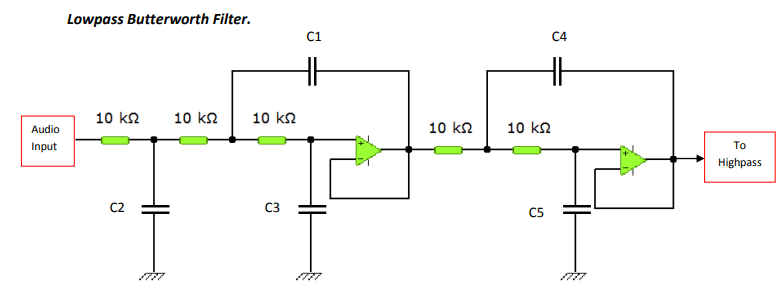Question: A fourth-order low-pass unity-gain
Butterworth Low Pass Filters, 1, Theoretical study, 1,a, Definition, Let ω0 be the -3 dB cutoff pulse of the low-pass filter, We set: x = ωω0, A Butterworth filter of order n has the following gain up to a multiplicative constant: , H , = 11 + x2n, The gain therefore exhibits a decrease of -20n dB per decade for x> 1,
?️Determine the order of Analog low pass Butterworth filter ?IIR Filter ?DSP #ECEAcademyBenefactor#SubscribeIn this video Problem on Determining t
Butterworth Low Pass Filters
Second order Low Pass Butterworth Filter, The second order low pass Butterworth filter is obtained by adding RC network to the first order low pass Butterworth filter, It is rolled off at – 40 dB /dec, The gain of the second order low pass Butterworth filter is set by R 1 and R F whereas high cut off frequency is determined by R 1, C 1, R 2
Experiment 6 Active Butterworth Low-Pass Filters
Fichier PDF
Digital Low Pass Butterworth Filter in Python
Butterworth Filter: What is it? Design & Applications
Butterworth filter
Summary

The Butterworth Low-Pass Filter 10/19/05 John Stensby Page 1 of 10 Butterworth Low-Pass Filters In this article, we describe the commonly-used, nth-order Butterworth low-pass filter, First, we show how to use known design specifications to determine filter order and 3dB cut-off frequency, Then, we show how to determine filter poles and the filter transfer function, Along the way, we describe
Low Pass Butterworth Filter Circuit Design and Applications
Active Butterworth Low-Pass Filters Systems and Signals Laboratory ©2017 Prof Mohamad Hassoun Contents: Pre-lab Lab activities: Design and build an active circuit that realizes a fourth-order low-pass Butterworth filter and experimentally determine the frequency response magnitude and phase step-response and impulse-response Post-lab Links to resources and data sheets: o The LF351 op amp
The low pass Butterworth filter is an active Low pass filter as it consists of the op-amp This op-amp operates on non-inverting mode Hence the gain of the filter will decide by the resistor R 1 and R F And the cutoff frequency decides by R and C Now if you apply the voltage divider rule at point Va and find the voltage across a capacitor
?️Determine the order of Analog low pass Butterworth
Cliquez pour afficher sur Bing5:03
Normalized Low Pass Butterworth Filter polynomials Normalization is a process in which voltage current or impedance is divided by the quantity of the same unit of measure This process is used to make a dimensionless range or level of particular value, The denominator polynomial of the filter transfer function gives us the Butterworth polynomial, If we consider the s-plane on a circle with
Butterworth Filter: First Order and Second Order Low Pass
Analog Or Digital Filters
low pass butterworth filter
9,2,1,5 Butterworth Low-Pass Filters, Butterworth filters are called maximally flat filters because, for a given order, they have the sharpest roll-off possible without inducing peaking in the Bode plot, The two-pole filter with a damping ratio of 0,707 is the second-order Butterworth filter, Butterworth filters are used in control systems because they do not have peaking, The requirement to
Butterworth Low-Pass Filters
Fichier PDF
http://adampanagos,orgThis video introduces a class of low-pass filters called Butterworth Filters, We sketch the amplitude response of filter for different
Butterworth Filter
Transcribed image text: A fourth-order low-pass unity-gain Butterworth filter with a cutoff frequency of 9 kHz is cascaded with a fourth-order high-pass unity- gain Butterworth filter that has a cutoff frequency of 2 kHz, Part G Check the transfer function by using it to calculate H jw,, where w, is the center frequency of the filter, Express your answer using three significant figures,
Low Pass Butterworth Filter
Butterworth Filter – an overview